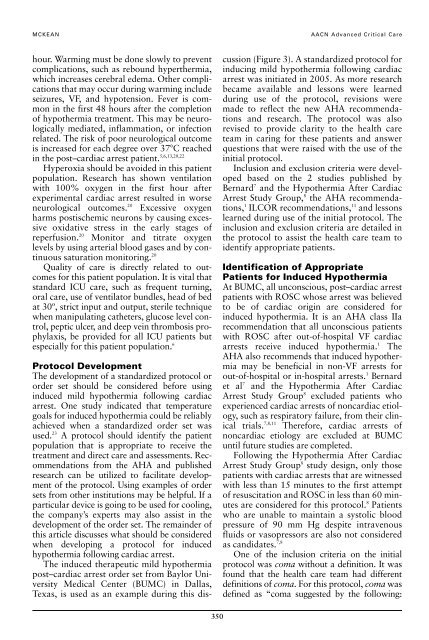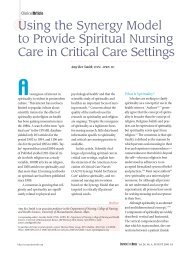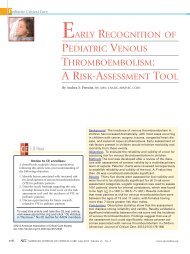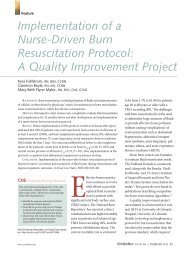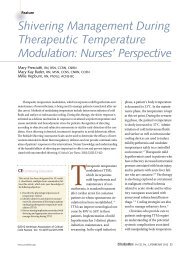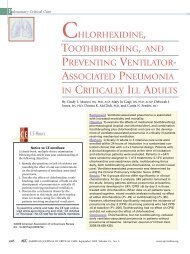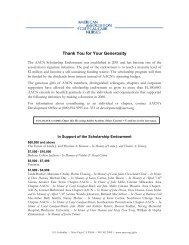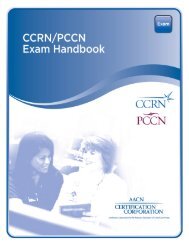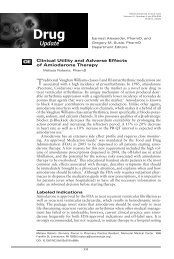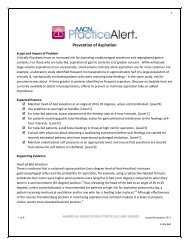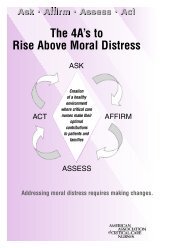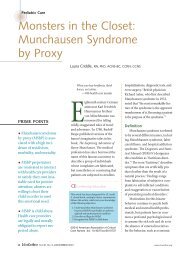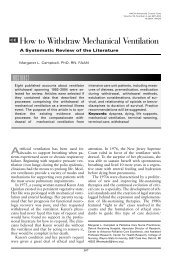Induced Moderate Hypothermia After Cardiac Arrest - American ...
Induced Moderate Hypothermia After Cardiac Arrest - American ...
Induced Moderate Hypothermia After Cardiac Arrest - American ...
You also want an ePaper? Increase the reach of your titles
YUMPU automatically turns print PDFs into web optimized ePapers that Google loves.
MCKEAN<br />
AACN Advanced Critical Care<br />
hour. Warming must be done slowly to prevent<br />
complications, such as rebound hyperthermia,<br />
which increases cerebral edema. Other complications<br />
that may occur during warming include<br />
seizures, VF, and hypotension. Fever is common<br />
in the first 48 hours after the completion<br />
of hypothermia treatment. This may be neurologically<br />
mediated, inflammation, or infection<br />
related. The risk of poor neurological outcome<br />
is increased for each degree over 37C reached<br />
in the post–cardiac arrest patient. 5,6,13,20,22<br />
Hyperoxia should be avoided in this patient<br />
population. Research has shown ventilation<br />
with 100% oxygen in the first hour after<br />
experimental cardiac arrest resulted in worse<br />
neurological outcomes. 20 Excessive oxygen<br />
harms postischemic neurons by causing excessive<br />
oxidative stress in the early stages of<br />
reperfusion. 20 Monitor and titrate oxygen<br />
levels by using arterial blood gases and by continuous<br />
saturation monitoring. 20<br />
Quality of care is directly related to outcomes<br />
for this patient population. It is vital that<br />
standard ICU care, such as frequent turning,<br />
oral care, use of ventilator bundles, head of bed<br />
at 30º, strict input and output, sterile technique<br />
when manipulating catheters, glucose level control,<br />
peptic ulcer, and deep vein thrombosis prophylaxis,<br />
be provided for all ICU patients but<br />
especially for this patient population. 6<br />
Protocol Development<br />
The development of a standardized protocol or<br />
order set should be considered before using<br />
induced mild hypothermia following cardiac<br />
arrest. One study indicated that temperature<br />
goals for induced hypothermia could be reliably<br />
achieved when a standardized order set was<br />
used. 23 A protocol should identify the patient<br />
population that is appropriate to receive the<br />
treatment and direct care and assessments. Recommendations<br />
from the AHA and published<br />
research can be utilized to facilitate development<br />
of the protocol. Using examples of order<br />
sets from other institutions may be helpful. If a<br />
particular device is going to be used for cooling,<br />
the company’s experts may also assist in the<br />
development of the order set. The remainder of<br />
this article discusses what should be considered<br />
when developing a protocol for induced<br />
hypothermia following cardiac arrest.<br />
The induced therapeutic mild hypothermia<br />
post–cardiac arrest order set from Baylor University<br />
Medical Center (BUMC) in Dallas,<br />
Texas, is used as an example during this discussion<br />
(Figure 3). A standardized protocol for<br />
inducing mild hypothermia following cardiac<br />
arrest was initiated in 2005. As more research<br />
became available and lessons were learned<br />
during use of the protocol, revisions were<br />
made to reflect the new AHA recommendations<br />
and research. The protocol was also<br />
revised to provide clarity to the health care<br />
team in caring for these patients and answer<br />
questions that were raised with the use of the<br />
initial protocol.<br />
Inclusion and exclusion criteria were developed<br />
based on the 2 studies published by<br />
Bernard 7 and the <strong>Hypothermia</strong> <strong>After</strong> <strong>Cardiac</strong><br />
<strong>Arrest</strong> Study Group, 8 the AHA recommendations,<br />
1 ILCOR recommendations, 11 and lessons<br />
learned during use of the initial protocol. The<br />
inclusion and exclusion criteria are detailed in<br />
the protocol to assist the health care team to<br />
identify appropriate patients.<br />
Identification of Appropriate<br />
Patients for <strong>Induced</strong> <strong>Hypothermia</strong><br />
At BUMC, all unconscious, post–cardiac arrest<br />
patients with ROSC whose arrest was believed<br />
to be of cardiac origin are considered for<br />
induced hypothermia. It is an AHA class IIa<br />
recommendation that all unconscious patients<br />
with ROSC after out-of-hospital VF cardiac<br />
arrests receive induced hypothermia. 1 The<br />
AHA also recommends that induced hypothermia<br />
may be beneficial in non-VF arrests for<br />
out-of-hospital or in-hospital arrests. 1 Bernard<br />
et al 7 and the <strong>Hypothermia</strong> <strong>After</strong> <strong>Cardiac</strong><br />
<strong>Arrest</strong> Study Group 8 excluded patients who<br />
experienced cardiac arrests of noncardiac etiology,<br />
such as respiratory failure, from their clinical<br />
trials. 7,8,11 Therefore, cardiac arrests of<br />
noncardiac etiology are excluded at BUMC<br />
until future studies are completed.<br />
Following the <strong>Hypothermia</strong> <strong>After</strong> <strong>Cardiac</strong><br />
<strong>Arrest</strong> Study Group 8 study design, only those<br />
patients with cardiac arrests that are witnessed<br />
with less than 15 minutes to the first attempt<br />
of resuscitation and ROSC in less than 60 minutes<br />
are considered for this protocol. 8 Patients<br />
who are unable to maintain a systolic blood<br />
pressure of 90 mm Hg despite intravenous<br />
fluids or vasopressors are also not considered<br />
as candidates. 7,8<br />
One of the inclusion criteria on the initial<br />
protocol was coma without a definition. It was<br />
found that the health care team had different<br />
definitions of coma. For this protocol, coma was<br />
defined as “coma suggested by the following:<br />
350


